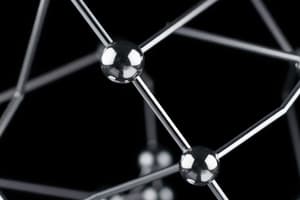Podcast
Questions and Answers
What is the molecular geometry for 4 bonding pairs and 0 lone pairs?
What is the molecular geometry for 4 bonding pairs and 0 lone pairs?
- Bent
- Trigonal planar
- Trigonal pyramidal
- Tetrahedral (correct)
What is the geometry for 3 bonding pairs and 1 lone pair?
What is the geometry for 3 bonding pairs and 1 lone pair?
Trigonal pyramidal
What is the geometry for 2 bonding pairs and 2 lone pairs?
What is the geometry for 2 bonding pairs and 2 lone pairs?
Bent
What is the molecular geometry for 1 bonding pair and 3 lone pairs?
What is the molecular geometry for 1 bonding pair and 3 lone pairs?
What is the shape for 3 bonding pairs and 0 lone pairs?
What is the shape for 3 bonding pairs and 0 lone pairs?
What is the geometry for 2 bonding pairs and 1 lone pair?
What is the geometry for 2 bonding pairs and 1 lone pair?
What is the molecular geometry for 1 bonding pair and 2 lone pairs?
What is the molecular geometry for 1 bonding pair and 2 lone pairs?
What is the geometry for 2 bonding pairs and 0 lone pairs?
What is the geometry for 2 bonding pairs and 0 lone pairs?
What is the geometry for 1 bonding pair and 1 lone pair?
What is the geometry for 1 bonding pair and 1 lone pair?
Flashcards are hidden until you start studying
Study Notes
VSEPR Theory - Molecular Geometries
- Tetrahedral geometry is characterized by four bonding pairs and no lone pairs on the central atom, leading to bond angles of approximately 109.5°.
- Trigonal pyramidal geometry features three bonding pairs and one lone pair, resulting in a bond angle of less than 109.5° due to lone pair repulsion.
- Bent geometry arises when there are two bonding pairs and two lone pairs, creating bond angles typically around 104.5°.
- Linear geometry occurs with one bonding pair and three lone pairs, or with one bonding pair and two lone pairs, where the bond angle is 180° due to the arrangement.
- Trigonal planar geometry includes three bonding pairs and no lone pairs, with bond angles of 120°.
- Bent geometry can also result from two bonding pairs and one lone pair, which reduces the bond angle similarly to the configuration with two lone pairs but maintains some angular distortion.
- Linear shapes may also emerge from two bonding pairs and no lone pairs, emphasizing a straight-line molecular structure.
- A consistent trend in VSEPR theory shows that lone pairs exert greater repulsion compared to bonding pairs, influencing the molecular shape significantly.
Studying That Suits You
Use AI to generate personalized quizzes and flashcards to suit your learning preferences.




